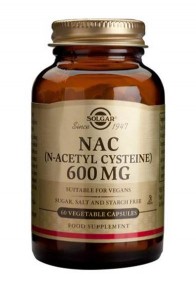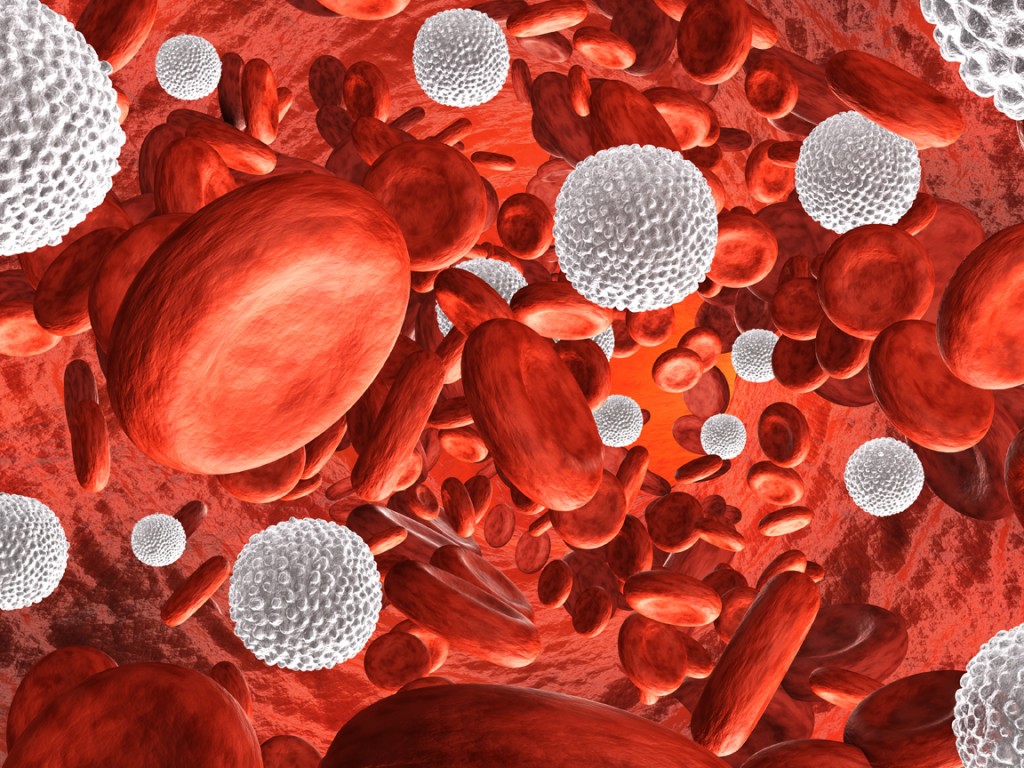Inflammatory Marker NF-kB Elevated in Adolescent Bipolar Disorder
In a poster at the 2014 meeting of the American Academy of Child and Adolescent Psychiatry, researcher Larissa Portnoff reported that NF-kB, a marker of inflammation that can be measured in two types of white blood cells (lymphocytes and monocytes), was significantly elevated in adolescents who had bipolar disorder compared to healthy control participants.
Several other inflammatory markers have been linked to bipolar disorder, including c-reactive protein (CRP) and TNF alpha. The new data about NF-kB suggests that another inflammatory pathway is overactive in the disorder. NF-kB levels did not correlate with the severity of manic or depressive symptoms, as do levels of some other inflammatory markers.
Lamotrigine Effective in Bipolar I Prevention in Adolescents
At the 2014 meeting of the American Academy of Child and Adolescent Psychiatry, researcher Robert Findling reported on a double blind, placebo controlled 36-week study of lamotrigine for children and adolescents with bipolar I disorder. The doses designed for maintenance treatment averaged about 225 mg/day, achieved by very slow increases over time in order to reduce the risk of a serious rash.
Findling found that lamotrigine was more effective than placebo in extending the time until a patient required an intervention for a new mood episode among the older children in the study (aged 13 to 17). Among the younger children in the study (aged 10 to 12), lamotrigine’s effects were not statistically significant compared to placebo. Findling and colleagues concluded that lamotrigine appeared effective in delaying time to onset of a new episode in adolescents with bipolar I disorder.
Lamotrigine is approved by the Federal Drug Administration (FDA) for bipolar disorder in adults only.
Older Fathers More Likely to Have Offspring with Bipolar Disorder
In a huge study of Swedish siblings, a sibling was 24.7 times more likely to have bipolar disorder if the father was older (over age 45) at the time of the birth than younger (younger than 24). Older paternal age was also associated with other risks of mental disorders, such as autism, attention deficit hyperactivity disorder (ADHD), suicide attempts, substance abuse and psychosis, but the strongest finding was of a relationship with bipolar disorder.
Mutations that occur during the production of sperm may be responsible for the increased risk of illness in the offspring of older fathers.
The population-based cohort study published by Brian M. D’Onofrio et al. in the journal JAMA Psychiatry included all individuals born in Sweden between 1973 and 2001.
Differentiating ADHD and Bipolar Disorder
Three articles in the September 2014 issue of the journal Psychiatric Annals (Volume 44 Issue 9) discussed differentiating pediatric bipolar disorder from attention deficit hyperactivity disorder (ADHD). The first article, by Regina Sala et al., said that reasons to suspect bipolar disorder in a child with ADHD include:
- The ADHD symptoms appear for the first time after age 12.
- The ADHD symptoms appear abruptly in an otherwise healthy child.
- The ADHD symptoms initially responded to stimulnts and then did not.
- The ADHD symptoms come and go and occur with mood changes.
- A child with ADHD begins to have periods of exaggerated elation, grandiosity, depression, decreased need for sleep, or inappropriate sexual behaviors.
- A child with ADHD has recurring severe mood swings, temper outbursts, or rages.
- A child with ADHD has hallucinations or delusions.
- A child with ADHD has a strong family history of bipolar disorder in his or her family, particularly if the child does not respond to appropriate ADHD treatments.
The second article, by this editor Robert Post, Robert Findling, and David Luckenbaugh, emphasized the greater severity and number of symptoms in childhood onset bipolar disorder versus ADHD. Children who would later develop bipolar disorder had brief and extended periods of mood elevation and decreased sleep in the early years of their lives. These, along with pressured speech, racing thoughts, bizarre behavior, and grandiose or delusional symptoms emerged differentially from age three onward. In contrast, the typical symptoms of ADHD such as hyperactivity, impulsivity, and decreased attention were equal in both diagnoses.
In the third article, Mai Uchida et al. emphasized the utility of a family history of bipolar disorder as a risk factor. Moreover, a child with depression plus ADHD is at increased risk for a switch into mania on antidepressants if there is a family history of mood disorders, emotional and behavioral dysregulation, subthreshold mania symptoms, or psychosis.
The differential diagnosis of ADHD versus bipolar disorder (with or without comorbid ADHD) is critical, as drug treatment of these disorders is completely different.
Bipolar disorder is treated with atypical antipyschotics; anticonvulsant mood stabilizers, such as valproate, carbamazepine, or lamotrigine; and lithium. Only once mood is stabilized should small doses of stimulants be added to treat residual ADHD symptoms.
ADHD, conversely, is treated with short- or long-acting stimulants such as amphetamine or methylphenidate from the onset, and these may be augmented by the noradrenergic alpha-2 agonists guanfacine or clonidine. The selective noradrenergic re-uptake inhibitor atomoxetine is also approved by the Federal Drug Administration (FDA) for the treatment of ADHD. The dopamine-active drug bupropion and the anti-narcolepsy drugs modafinil and armodafinil have mild anti-ADHD effects but have not been FDA-approved for that purpose.
Antidepressant Use Dropping in Bipolar Disorder in Spain
In the clinic of researcher Eduard Vieta in Barcelona, a study was recently completed showing that antidepressant use in patients with bipolar disorder (where antidepressants are not effective) had dropped from around 50-60% in 2007 (in Baldessarini’s study) to about 30% in 2013 and 2014, and conversely lithium, anticonvulsants, and atypical antipsychotics, which have much more evidence of efficacy, were all used much more often, or about 60% of the time.
Editor’s Note: Hopefully these data from Spain will soon be matched by similar data in the US showing that evidenced-based treatments for bipolar depression are in fact being used instead of antidepressants, which can have adverse effects, such as switching into mania or cycle acceleration.
High Risk of Suicide Attempts in Bipolar Disorder with Substance Abuse
At the 2014 meeting of the International College of Neuropsychopharmacology, researcher Rieva et al. reported that 60% of bipolar patients with comorbid alcohol abuse have attempted suicide, and 48% of bipolar patients with cocaine abuse have attempted suicide. Thus, both of these comorbidities deserve specific attention and treatment. Unfortunately there are currently no Federal Drug Administration–approved drugs for bipolar patients with these comorbidities. The most promising treatments, based on data in patients with primary addictions, are the nutritional supplement N-acetylcysteine and topiramate, which have both performed better than placebo in studies of alcohol and cocaine abuse disorders.
A Symposium on High Risk Studies: Offspring of Parents with Bipolar Disorder
In a symposium at the 2014 meeting of the International College of Neuropsychopharmacology, four researchers shared insights on children who are at higher risk for bipolar disorder because they have a parent with the disorder.
Researcher John Nurnberger has been studying 350 children of parents with bipolar disorder in the US and 141 control children of parents with no major psychiatric disorder, following the participants into adolescence. He found a major affective disorder in 23.4% of the children with parents who have bipolar disorder and 4.4% of the controls. Of the at-risk children, 8.5% had a bipolar diagnosis versus 0% of the controls.
Nurnberger found that disruptive behavior disorders preceded the onset of mood disorders, as did anxiety disorders. These diagnoses predicted the later onset of bipolar disorder in the at-risk children, but not in the controls. A mood disorder in early adolescence predicted a substance abuse disorder later in adolescence among those at risk.
In genome-wide association studies, the genes CACNA1C and ODZ4 are consistently associated with risk of bipolar disorder, but with a very small effect size. Therefore, Nurnberger used 33 different gene variants to generate a total risk score and found that this measure was modestly effective in identifying relative risk of developing bipolar disorder. He hopes that using this improved risk calculation along with family history and clinical variables will allow better prediction of the risk of bipolar onset in the near future.
Researcher Ann Duffy reported on her Canadian studies of children who have a parent with bipolar disorder and thus are at high risk for developing the disorder. In contrast to the studies of Nurnberger et al. and many others in American patients, she found almost no childhood onset of bipolar disorder before late adolescence or early adulthood. She found that anxiety disorders emerge first, followed by depression, and then only much later bipolar disorder. Bipolar disorder occurred with comorbid substance abuse disorders in only about 10-20% of cases in 1975, but substance abuse increased to 50% of bipolar cases in 2005. The incidence of comorbid substance disorder and the year at observation correlated strongly, indicating a trend toward increased substance abuse over the 30-year period.
Duffy found that having parents who were ill as opposed to recovered was associated with a more rapid onset of mood disorder in the offspring, usually in early adulthood. Duffy emphasized the need to intervene earlier in children of parents with bipolar disorder, but this is rarely done in clinical practice. Read more
Memory Tips for Bipolar Disorder
 Like cancer patients undergoing chemotherapy, patients with bipolar disorder often have memory problems, particularly if they have had many prior episodes. Some memory tips from CancerCare’s Chemobrain Information Series may also help patients with bipolar disorder remember things better and keep their memory sharp. Here are some of their tips:
Like cancer patients undergoing chemotherapy, patients with bipolar disorder often have memory problems, particularly if they have had many prior episodes. Some memory tips from CancerCare’s Chemobrain Information Series may also help patients with bipolar disorder remember things better and keep their memory sharp. Here are some of their tips:
Make lists. Carry a notepad with you, or use a smartphone to keep track of errands, shopping lists, daily tasks, and when you should take your medications.
Use a paper or electronic day planner or a personal organizer to keep track of appointments and special days like birthdays or anniversaries.
Use a wall calendar and hang it in a place that you will see it multiple times per day.
Carry a notebook and record everything you need to remember, including to-do lists; the dates, times, and addresses of appointments; important telephone numbers; and the names of people you meet and a brief description of them. You can also use the notebook to keep track of medical information: your medication schedule, any symptoms or side effects you are having, or questions to ask your doctor. You can also do this using an app like What’s My M3 or by downloading a personal mood charting calendar from our website.
Leave yourself a voicemail message to remember something important. When you listen to it later, write down the information.
Organize your home or office. Keep things in familiar places so you always know where to find them.
Avoid distractions. Find a quiet, uncluttered place to work or think where you can focus your attention for longer.
Have conversations in quiet places. This will help you concentrate better on what the other person is saying.
Repeat information aloud, and write down important points. If someone gives you information about an appointment, you might repeat the time, date, and location of the appointment out loud while righting it down.
Keep your mind active. You can use crossword puzzles, word or math games, or attend events about topics that interest you.
When writing, proofread. Double-check whether you’ve used the correct words and spellings.
Train yourself to focus through mindfulness. For example, if you keep misplacing your keys, pay extra attention each time you set down your keys. You may say aloud, “I’m putting my keys down on the counter.” Hearing the auditory cue can boost your memory.
Exercise, eat well, and get plenty of rest and sleep. These habits will help your memory work best.
Tell your loved ones that you are having memory problems, so that they’ll understand that you may forget things you may normally be able to remember. They can help you or encourage you.
Diabetes May Contribute to Low Hippocampal Volume in Bipolar Disorder
Type 2 diabetes can damage the brain, particularly by reducing volume of the hippocampus, and frequently occurs in patients with bipolar disorder. A recent study of patients with bipolar disorder and abnormal glucose metabolism showed that patients with bipolar disorder who also had insulin resistance, glucose intolerance, or type 2 diabetes had smaller hippocampi than both patients with bipolar disorder and normal glucose function and normal control participants without a psychiatric disorder. In those with bipolar disorder and glucose abnormalities, age was associated with lower hippocampal volume to a greater extent than in bipolar patients with normal glucose function.
In the study, published by Tomas Hajek et al. in the journal Neuropsychopharmacology, not only did diabetes or prediabetes reduce the size of the hippocampus, but also reduced gray matter in the cerebral cortex, including the insula.
The researchers hope that treating diabetes, or possibly even its initial symptoms, more effectively may prevent these gray matter losses and slow brain aging in patients with bipolar disorder.
N-acetylcysteine May Improve Prodromal Schizophrenia
 At the 2014 meeting of the International College of Neuropsychopharmacology, researcher N. Miyake described the effects of the nutritional supplement n-acetylcysteine (NAC) on clinical symptoms in subjects with subthreshold symptoms of psychosis.
At the 2014 meeting of the International College of Neuropsychopharmacology, researcher N. Miyake described the effects of the nutritional supplement n-acetylcysteine (NAC) on clinical symptoms in subjects with subthreshold symptoms of psychosis.
N-acetylcysteine, a glutathione precursor, has neuroprotective effects. In this case series, four patients with subthreshold psychosis were given 2000mg/day of NAC for 12 weeks. The patients’ symptoms improved to the point that three of the four were no longer considered at risk for psychosis.
Editor’s Note: These promising anecdotal observations deserve careful follow up using a control group. Omega-3 fatty acids have been show to slow conversion to full psychosis and performed better than placebo in a controlled study. Both n-acetylcysteine and omega-3 fatty acids should definitely be studied for those with emerging symptoms of bipolar disorder.









